Folks don’t want to talk about the pandemic anymore, but we should, for despite all the awful things that happened, and the massive divisions it has caused in society, one thing is clear: the way that organizations organize, learners learn, science sciences, and experts’ expertise, has forever changed.
We learned a tremendous number of lessons as to how to do things better, faster, and with more insight than ever before, and that’s why trend #15 of my “23 Trends for 2023” is Locking in Lessons Learned.
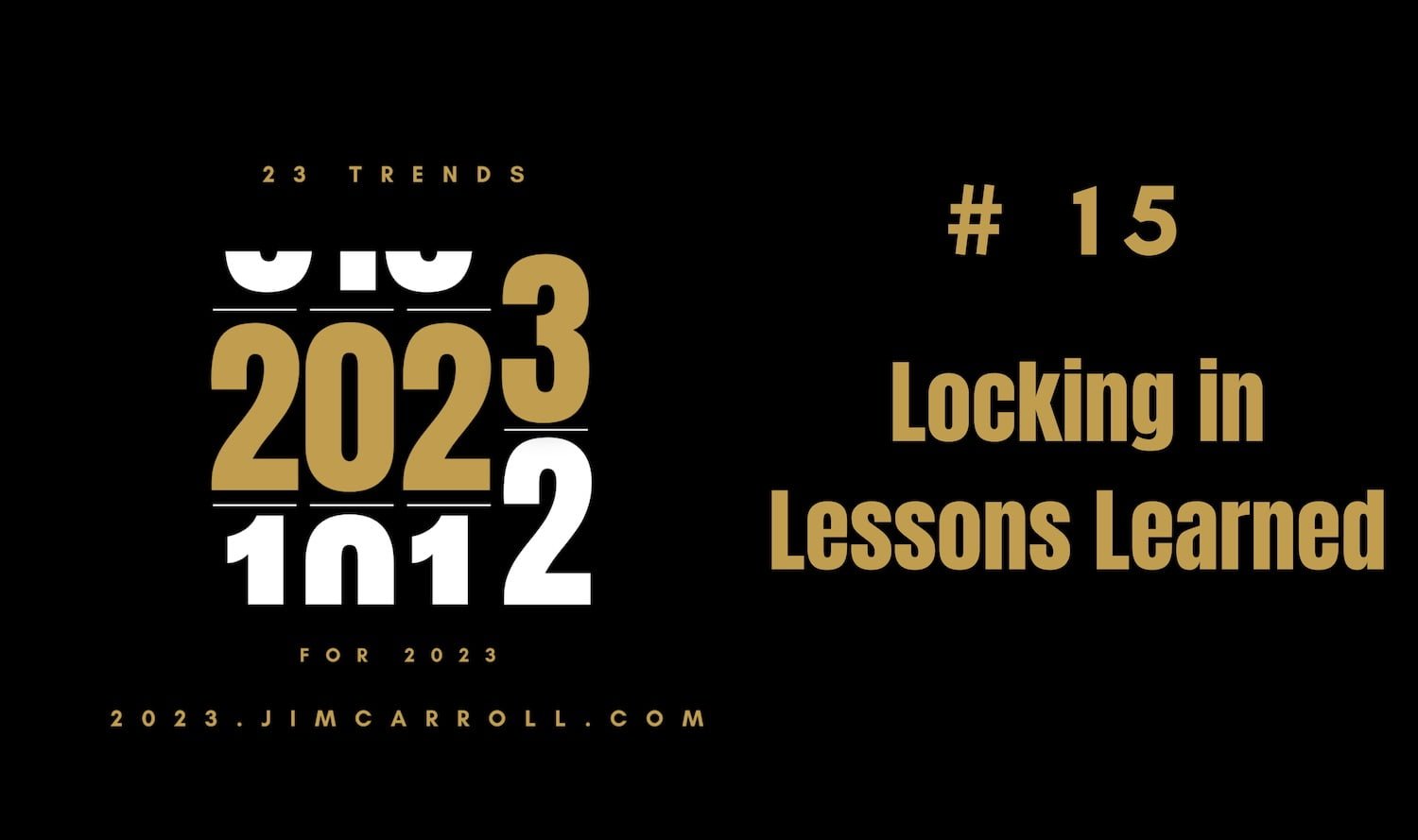
What I am now noticing among the inquiries by CEOs and senior executives for events in 2023 is along the lines of: “our organizations changed during the pandemic – in some ways for the better. How do we capitalize on what we’ve learned?” In other words, how do we lock them in?
I started capturing this on stage early in my return to in-person events; here’s a clip from an event in Detroit last year where I was summarizing the lessons learned.
This goes to one of my key points – that the pandemic accelerated the goal of many organizations to focus on ‘digital transformation – that is, how do we align our workforce, supply chain, operating methodologies, and more to take advantage of the opportunities that widespread connectivity presents us. Organizations have talked about this goal for years – the pandemic simply accelerated the trend to a HUGE degree. I remember seeing this on Twitter early into the pandemic.
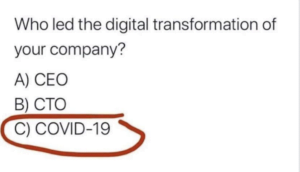
The real impact of covid on business? We’ve learned to operate at speed, and there is no going back! Consider the reality of what we have learned through these remarkable times:
- we compressed 10 years of change into but 6 months
- the result is that major trends accelerated
- such that organizations learned something new about speed!
- and agility and flexibility became critical!
- the impact is that business models shifted faster
- as people become more adaptable to new interaction methods!
- the attitude ‘it can’t be done!’ disappeared
- and decision-making paralysis disappeared
- a slow organizational structure was put under a microscope
- old barriers to new ideas disappeared
- and getting it done became the rallying cry!
And now? Organizations are busy learning how to keep what they’ve learned – how can we sustain the momentum, and lock in these gains?
The same thing happened in the world of science and healthcare. I grabbed this screenshot in mid-April 2020 – it was one of many emergency room doctors I was following online because I realized that small communities of specialists were forming online in order to share insight on how to deal with fast-moving and entirely unknown new circumstances. Something profound was happening in the world of medical science, and I wanted to understand it.
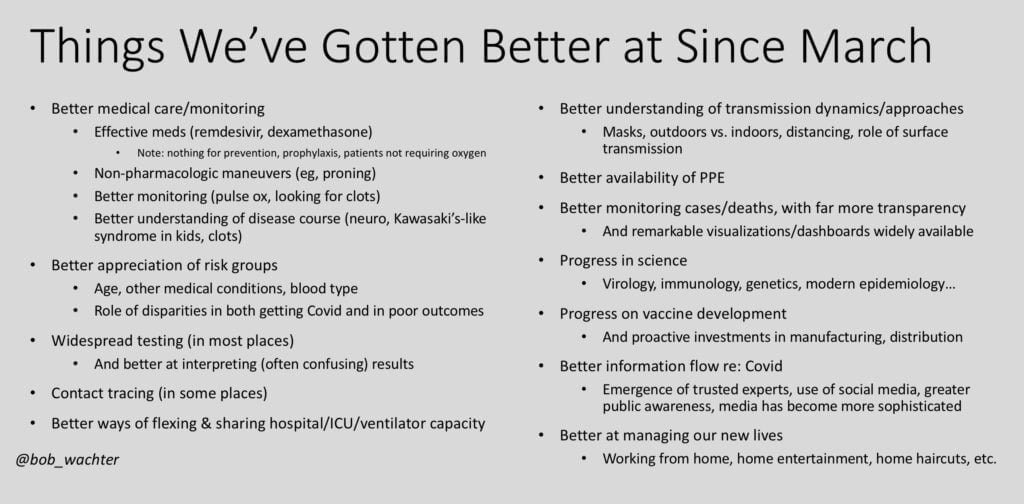
Today, these small micro-communities still exist in multiple forums, and the manner by which medical and healthcare specialists share insight at speed has forever changed our world going forward.
But it’s not just information sharing – the very nature of R&D has forever changed. Overall, the entire world of medical, pharmaceutical, and science technology accelerated to a ridiculous degree during the pandemic – I often share the statistic that while the volume of medical knowledge was doubling every 8 years before Covid, months into the pandemic it was doubling every 78 days.
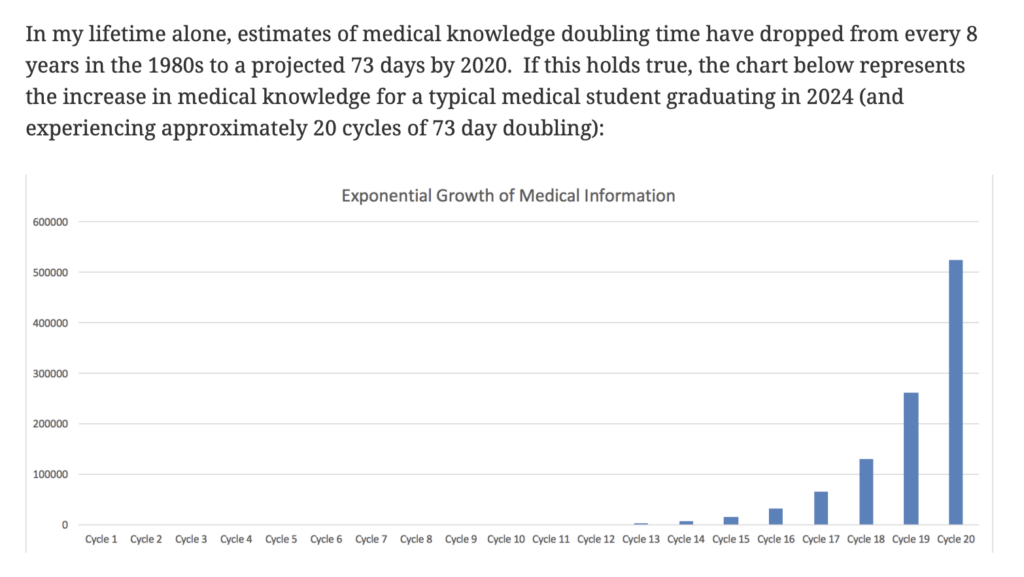
The overall impact was that the pace of innovation accelerated: consider this post.
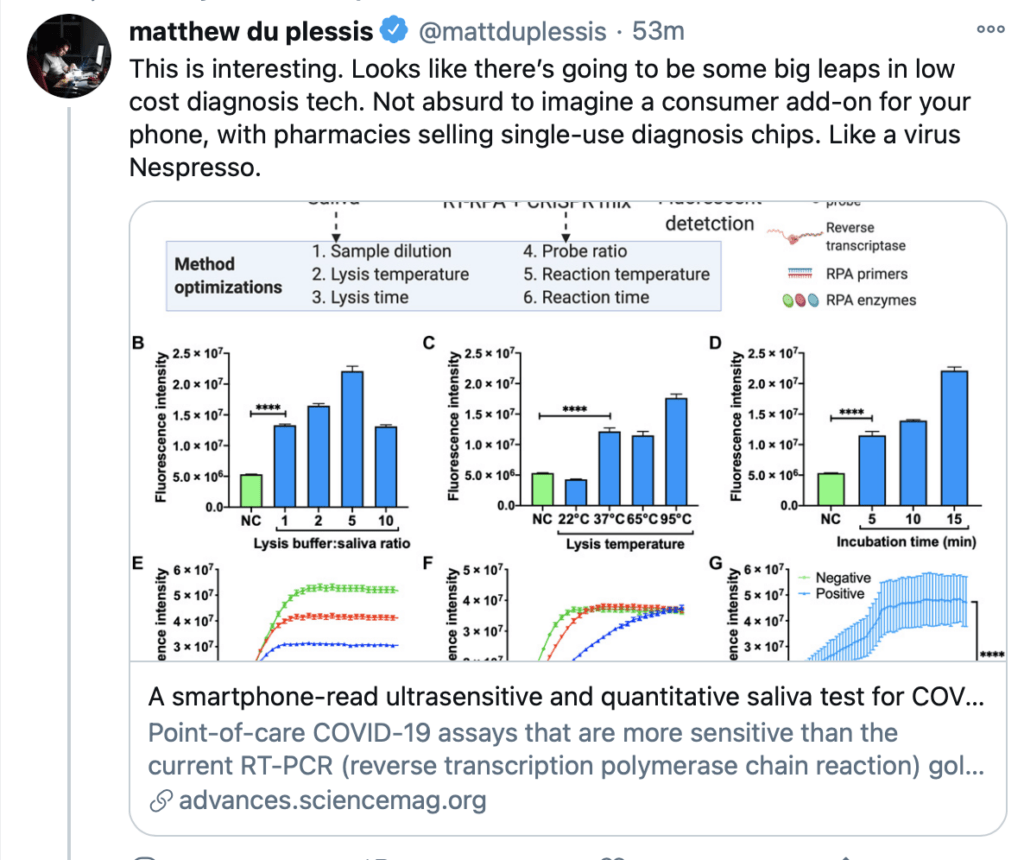
The best way to think about it? Scientists working at warp speed:

There is no shortage of reports in the press about how much of an impact this has had on the entire process of scientific collaboration:
A team of Oxford University economists studying the discovery of breakthrough scientific ideas recently analyzed millions of scholarly papers over seven decades and showed that we learned how to be productive through remote collaboration over the past 10 years. Technology we have come to know, love and hate during the pandemic gave us the tools to simulate working in person.
The Beatles, Beyoncé and How to Be Creative Today; What we can learn about collaboration and remote work from two pandemic hits
4 August 2022, The Wall Street Journal Online
…and the reality of simply more collaboration…
For those like me working in the life sciences, the pandemic demanded a rapid and effective response of new treatments and preventive measures. This transformed how we work.
Scientists are a competitive lot. They solve puzzles with single-minded purpose. Rarely do they reveal a discovery before reporting it in a journal.
This slow and linear process is not the best way to counter a frightening and mutating virus. A potent and swift response means that every possible expert joins the effort. This is how the pandemic changed the work life of life scientists. It made teamwork the imperative over the output of any individual.
This framework was born out of necessity. It calls for partnership and data sharing. Only by sharing insights before publication can others truly exploit any discovery. Otherwise, its full potential to improve the public’s health is not unleashed.
This is what happened during the coronavirus outbreak. In one recent case, South African scientists generously shared data that revealed the Omicron variant. This sounded the global public health alarm and guided international efforts to combat the emerging health challenge.
Examples like this forced life scientists to collaborate like never before. They assembled productive teams into public-private partnerships and shared with others what was learned, well before publication. This hastened progress against the pandemic.
The pandemic’s silver lining: collaboration among scientists
8 March 2022, The Baltimore Sun
At the same time, we saw data scientists around the world establish fast collaboration efforts
The curtains have come down on India’s first comprehensive and reliable covid-19 dashboard, but its legacy lives on.
Sparked by anonymous Reddit posts about the dearth of covid data, Jeremy Philemon, a computer science student from Bahrain, created an open-sourced website on GitHub that became the destination for all sorts of data—active cases, deaths, testing, and vaccination rates.
Covid19india.org was the labour of over 300 volunteers. The site, inspired by an open source covid tracker in Japan, had clocked upwards of 4.4 billion visits by August 2021.
India’s best covid data is coming from open-source collaboration
28 January 2022 Quartz
Back to corporate organizations: they also learned to work at warp speed. As supply chains broke, conversations and information sharing on how to fix them exploded.

…because what was happening was overall, we were learning entirely new skills, many having to do with resilience, dealing with volatility, and fast-moving events.
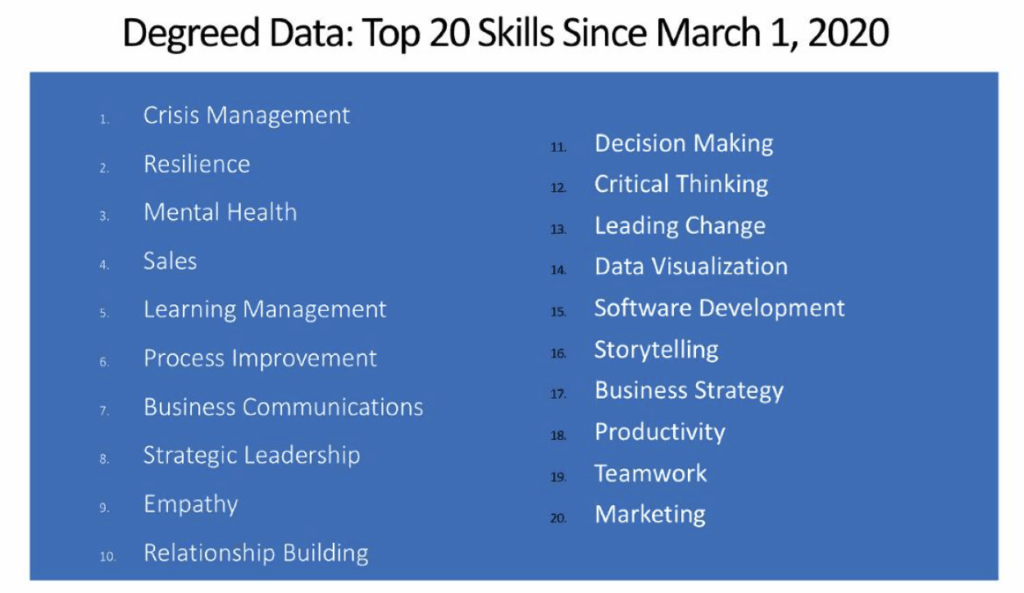
A sprinkling of just a few news articles gives you but a small sense of what happened.
In-person meetings among lawyers in the same law firm office may have plummeted during the pandemic. But law firm leaders say one perk from the time period was increased communication between lawyers in different offices.
And now there’s an effort to keep up that inter-office collaboration, especially using new technology that firms installed in the last 21⁄2 years for better remote communication.
During the period of remote work during the pandemic, law firm partners and associates had an easier time getting introduced to colleagues in other offices and getting high-level information about where opportunities may lie, some legal industry sources say.
Law Firms Emphasize Cross-Office Collaboration Post-Pandemic; THE FIRM
11 October 2022, Palm Beach Daily Business Review
…including inter-industry cooperation…
Chairman of the Tourism Linkages Network, Adam Stewart, says the COVID-19 pandemic brought about unprecedented collaboration between tourism stakeholders, which will be the blueprint for success going forward.
Participating in a panel discussion at the Invest Jamaica 2022 Business Conference, at the Montego Bay Convention Centre in St. James on November 29, Mr. Stewart, who is also Executive Chairman of Sandals Resorts International, said it was a humbling experience for stakeholders during the height of the COVID-19 onslaught, especially during the period of March 2020 when all the seaports and airports were ordered closed.
“[It is my sincere hope] that the collaborative spirit we saw then and what we are still seeing now will continue. It’s not what Sandals experienced. It’s what we all went through together. And, collectively, it was the first time that the cruise ships and the land base were working with the airlines,” he noted.
“We were working with companies like the Wynn Corporation and Disney. Everyone came together. Jamaica was a microcosm of what was taking place in the Caribbean. The Caribbean was a microcosm of what was taking place worldwide, and we came together in a way that showed that when there is a big enough problem, people can set aside competitive tensions and work to the greater good. I’d like to see a lot more of that as we move forward,” Mr. Stewart added.
COVID-19 Brought About Unprecedented Collaboration – Sandals Chairman
1 December 2022, Baltic Legal Updates
Collaboration – everywhere!
Connecticut’s fine arts museums – the stewards of hundreds of millions of dollars worth of artworks – are struggling to recover from a pandemic that closed them for months, cut deeply into attendance and membership, and left wide funding gaps in operating budgets.
The road back could take years.
But in a rare move, three museums in the Hartford area – The Wadsworth Atheneum Museum of Art in Hartford, the New Britain Museum of American Art and the Hill-Stead Museum in Farmington – have plans to work together to help each other chart a course out of the pandemic and beyond.
“The basic premise that all of us have agreed on is that Netflix is the competition and not each other,” Jeffrey N. Brown, the Wadsworth’s chief executive officer, said.Three area art museums pursue working together; Collaboration a response to pandemic hardships
27 November 2022 The Hartford Courant
Going forward, organizations and industries are going to concentrate on how to lock in those gains – but will do so in the context of new volatility
If any moment showcased Twitter’s influence as a hub for health information and advocacy, it was the first months of the COVID-19 pandemic.
As the world scrambled to piece together a picture of the novel coronavirus, physicians, scientists, and public health experts stepped up to share personal stories, data, and analyses on the platform under medical and pandemic-related hashtags.
#MedTwitter, a tag previously used by health professionals to network, organize, and share the daily joys and struggles of the profession, became a window to the front lines of the crisis at a time when official information was tightly controlled and sometimes out of step with the situation on the ground.
Posts under the viral hashtags #Masks4Canada and #CovidIsAirborne raised awareness about the efficacy of masks and the potential for airborne transmission of SARS-CoV-2 long before many health authorities acknowledged their importance publicly.
And when SARS-CoV-2 vaccines became available, volunteer vaccine hunters quickly filled a void in official communications to provide real-time data on available vaccination appointments across Canada.
Twitter also facilitated the recognition of long COVID as patients around the world swapped stories of complex and unfolding symptoms that were not initially recognized in health care and policy circles.
“Twitter has been a surprisingly effective communication tool to disseminate information globally and exchange ideas during the pandemic when time is critical and knowledge is frequently updating,” said Jennifer Kwan, a family physician in Burlington, Ont.
Bottom line? Our world changed, and the trend in 2023 is going to be: how do we capitalize on what we have learned, and keep that momentum going forward?
“It’s not a lesson learned if you don’t lock it in!” – Futurist Jim Carroll
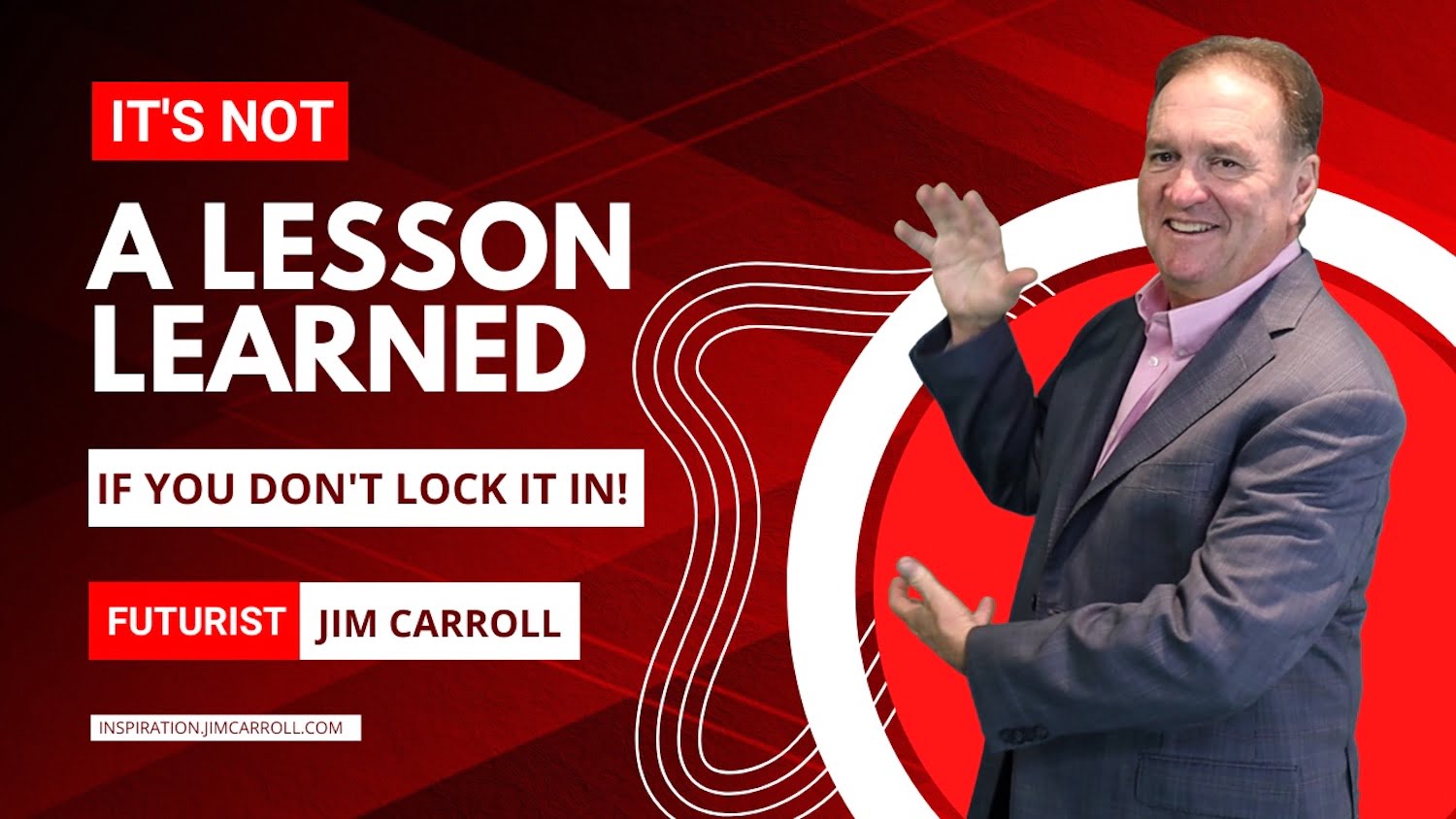




GET IN TOUCH
Jim's Facebook page
You'll find Jim's latest videos on Youtube
Mastodon. What's on Jim's mind? Check his feed!
LinkedIn - reach out to Jim for a professional connection!
Flickr! Get inspired! A massive archive of all of Jim's daily inspirational quotes!
Instagram - the home for Jim's motivational mind!